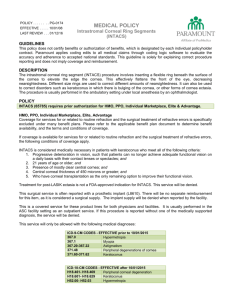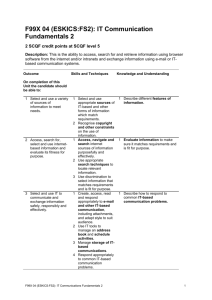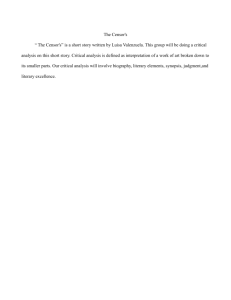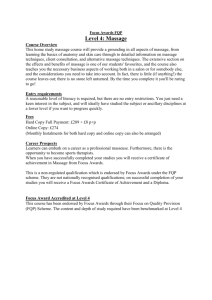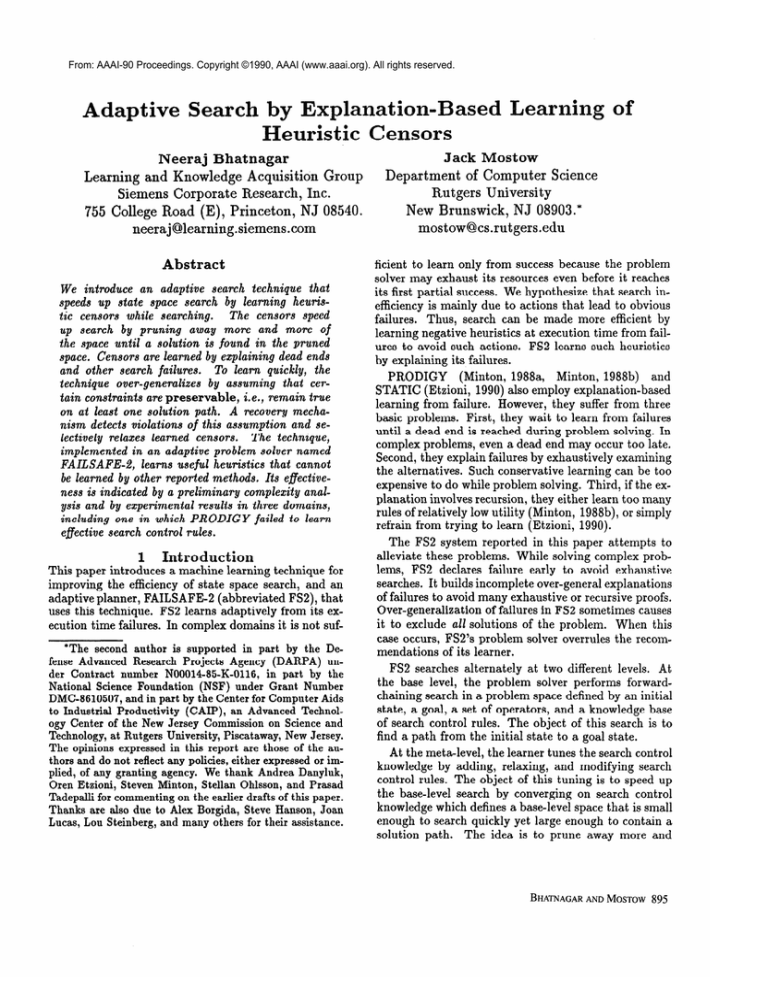
From: AAAI-90 Proceedings. Copyright ©1990, AAAI (www.aaai.org). All rights reserved.
tive Search
lanat ion-
ased Learning
of
ic Censors
Neeraj Bhatnagar
Learning and Knowledge Acquisition Group
Siemens Corporate Research, Inc.
755 College Road (E), Princeton, NJ 08540.
neeraj@learning.siemens.com
Abstract
We introduce an adaptive search technique that
speeds up state space search by learning heurisThe censors speed
tic censors while searching.
up search by pruning away moTe and more of
the space until a solution is found in the pruned
space. Censors are learned by explaining dead ends
To learn quickly, the
and other search failures.
technique over-generalizes
by assuming that certain constraints aTe preservable,
i.e., remain true
on at least one solution path. A recovery mechanism detects violations of this assumption and selectively relaxes learned censors.
The technique,
implemented in an adaptive problem solver named
FAILSAFE-g,
learns useful heuristics that cannot
be learned by other reported methods. Its effectiveness is indicated by a preliminary complexity analysis and by experimental results in three domains,
including one in which PRODIGY
failed to learn
eflective search control rules.
1
Introduction
This paper introduces a machine learning technique for
improving the efficiency of state space search, and an
adaptive planner, FAILSAFE-2
(abbreviated
FS2), that
uses this technique.
FS2 learns adaptively from its execution time failures. In complex domains it is not suf*The second author is supported in part by the Defense Advanced Research Projects Agency (DARPA) under Contract number N00014-85-K-0116,
in part by the
National Science Foundation (NSF) under Grant Number
DMC-861050’7, and in part by the Center for Computer Aids
to Industrial Productivity (CAIP), an Advanced Technology Center of the New Jersey Commission on Science and
Technology, at Rutgers University, Piscataway, New Jersey.
The opinions expressed in this report are those of the authors and do not reflect any policies, either expressed or implied, of any granting agency. We thank Andrea Danyluk,
Oren Etzioni, Steven Minton, Stellan Ohlsson, and Prasad
Tadepalli for commenting on the earlier drafts of this paper.
Thanks are also due to Alex Borgida, Steve Hanson, Joan
Lucas, Lou Steinberg, and many others for their assistance.
Jack Mostow
Department of Computer Science
Rutgers University
New Brunswick, NJ 08903.*
mostow@cs.rutgers.edu
ficient to learn only from success because the problem
solver may exhaust its resources even before it, reaches
its first partial success. We hypothesize
that search inefficiency is mainly due to actions that lead to obvious
failures. Thus, search can be made more efficient by
learning negative heuristics at execution time from failures to avoid such actions.
FS2 learns such heuristics
by explaining its failures.
PRODIGY
(Minton, 1988a,
Minton, 198823) and
STATIC (Etzioni,
1990) also employ explanation-based
learning from failure. However, they suffer from three
basic problems.
First,, they wait to learn from failures
until a dead end is reached during problem solving. In
complex problems, even a dead end may occur too late.
Second, they explain failures by exhaustively examining
the alternatives.
Such conservative learning can be too
expensive to do while problem solving. Third, if the explanation involves recursion, they either learn too many
rules of relatively low utility (Minton, 1988b), or simply
refrain from trying to learn (Etzioni, 1990).
The FS2 system reported in this paper attempts to
alleviate these problems.
While solving complex problems, FS2 declares failure early to avoid exhaustive
searches. It builds incomplete over-general explanations
of failures to avoid many exhaustive or recursive proofs.
Over-generalization
of failures in FS2 sometimes causes
it to exclude all solutions of the problem.
When this
case occurs, FS2’s problem solver overrules the recommendations of its learner.
FS2 searches alternately
at two different levels. At
the base level, the problem solver performs forwardchaining search in a problem space defined by an initial
state, a goal, a set of operators,
and a knowledge base
of search control rules. The object of this search is to
find a path from the initial state to a goal state.
At the meta-level, the learner tunes the search control
knowledge by adding, relaxing, and modifying search
control rules. The object of this tuning is to speed up
the base-level search by converging on search control
knowledge which defines a base-level space that is small
enough to search quickly yet large enough to contain a
The idea is to prune away more and
solution path.
BHATNAGARANDMOSTOW
895
more of the space until a solution is found.
FS2 views state space search as an enumeration
of allowed paths
until a solution
path
is found
(Mostow, 1983). FS2 addresses the case where the purpose of search is to find a legal but not necessarily optimal solution path quickly.
Learning speeds up the
search by constraining
the generation of paths so that
paths that are likely to fail are not generated.
z
Types
of constraints
on paths
Consider a constraint on the states occurring on a path.
We shall say that such a constraint
holds for a path if
it holds for every state in that path.
We classify such constraints
into three types. A necessary constraint holds for all solution paths and, therefore, must be preserved on the generated paths. If a necessary constraint
is violated, the problem solver must
backtrack.
A preservable constraint holds for some, but
not necessarily all solution paths. If a preservable constraint is violated, the problem solver may backtrack,
since other paths on which it is not violated also lead
to solutions. An unpreservable constraint does not hold
for any solution path, and must temporarily
be violated in order to reach the goal. If the problem solver
backtracks
every time an unpreservable
constraint
is
violated, it will cut off all solution paths. The type of
a constraint
depends on the operators available to the
problem solver, and on the other constraints
that the
problem solver is currently imposing.
FS2 extends previous work on FOO (Mostow, 1983)
and FAILSAFE
(Mostow and Bhatnagar,
1987). FOO
used the idea of necessary constraints
to interactively
derive heuristics for pruning the search. FAILSAFE
automated the derivation of such heuristics.
FS2 learns
preservable path constraints,
backtracks whenever they
are violated,
and recovers from unpreservable
constraints.
3
FS2’s
base-level
problem
solver
A state space problem is specified in FS2 by an initial state and a goal, both expressed as conjunctions
of ground literals. The problem solver does depth-first
forward search from the initial state. At every state it
has a current goal that it is currently trying to achieve,
and zero or more pending goals to achieve subsequently.
When the current goal is achieved, it is marked as protected, and the problem solver chooses an unsatisfied
pending goal as the new current goal.
The problem solver uses two types of search control
knowledge.
Goal selection rules constrain the selection
of which goal to pick as the next current goal. Censors
constrain the selection of which operator to apply to
the current state. If the problem solver tries to apply
an operator to a state, and the the preconditions
of the
operator are satisfied but applying it would violate a
censor, FS2 marks the state as suspended so that it can
be reconsidered if no solution is found otherwise.
In FS2 the problem
solver and the learner have
two types of interactions.
The first type occurs when
896 MACHINE LEARNING
the search is under-constrained.
Perfectly constrained
search proceeds straight to the goal without backtracking. Thus one symptom of under-constrained
search is
a dead end where no operators can be applied without
returning to an already-visited
state.
Another symptom is the violation of a protected goal. The problem
solver searches depth-first until any of these symptoms
occurs, at which point it declares a failure and invokes
the learner. The problem solver also declares a failure
and invokes the learner whenever the search depth for
the current goal exceeds a preset heuristic limit. The
purpose of this limit is to prevent runaway search down
fruitless alleys that have exponentially
deep dead ends
and never reach the goal.
If the learner is able to identify the problem solving step that led to the failure, it adds a new censor to prevent similar failures in future and instructs
the problem solver to resume search at the state just
before that step.
Otherwise
(for example,
when it
cannot explain the failure) it does not learn .a new
censor, and instructs the problem solver to backtrack
chronologically.
FS2’s resumption
of search at the
blamed point resembles dependency directed backtracking (Stallman and Sussman, 1977).
The other type of interaction
between the problem
solver and the learner occurs when the search is overconstrained.
Over-constrained
search prunes away all
solution paths.
It is manifested
when the problem
solver fails to continue making progress.
For example,
it runs out of states to expand but has not achieved
the goal.
Besides detecting
this extreme
case, FS2
uses some domain-independent
heuristics
to monitor
progress.
These heuristics detect sudden jumps from
a “good stat e” to a “bad state,” or from a “deep state”
to a “shallow state”. The first type of jump is defined
as a reduction of 50% or more in the number of satisfied goals between successively expanded states.
Such
a reduction may indicate an increase in the distance to
a total solution. The other type of jump is defined as a
reduction of 50% or more in search depth between successively expanded states.
Since the search is ordered
depth-first,
such a jump may indicate that progress is
being blocked by over-general censors. These heuristics
attempt to prevent FS2 from exploring a search space
rendered barren by over-general censors.
Whenever
any of these heuristics
apply, FS2 presumes that at least one of the suspended states was
wrongly suspended.
At this point the problem solver
calls a heuristic procedure that returns a pair <St, op>
and a censor C such that operator op is blocked by
the censor C in the suspended state st. The problem
solver resumes search by overruling C and applying op
to st. We call this process censor relaxation. The methods used to select st and op will be described in Section
4.3. If relaxing the censor leads to achieving the current
goal, FS2 infers that the censor was over-general
and
calls the learner to specialize it. If the space remains
over-constrained,
the heuristic procedure will eventuProblem solving continues until
ally be called again.
the goal is achieved or all censors are relaxed and no
solution is found.
4
How FS2 learns control
knowledge
FS2’s learner acquires several kinds of control knowledge, It learns rules to avoid hitting dead ends and
clobbering
protected
goals.
It learns rules to reorder
subgoals.
Since it sometimes
over-generalizes,
it also
identifies and repairs over-general rules.
When the learner is invoked, it is given the current
state, the path that led to it (but no other branches of
the search), the goals at each point on the path, and
the current set of censors. In addition to this dynamic
information
the learner also makes use of the following static knowledge, which depends on the problem
domain but does not change during problem-solving.
The operator definitions describe the problem solving
operators for the domain in a STRIPS-like
representation conducive to goal regression.
The domain theory
represents static aspects of the state or problem, e.g.,
(block a), (connects door12 room1 rooma). While the
operator definitions and domain theory may suffice to
explain success, they may not explain failures. Therefore a domain-specific
theory of failure is used to explain
why a given state fails to satisfy the current goal. This
theory specifies pairs A and B such that A is a possible goal, B is a conjunctive
condition, and A and B
cannot hold simultaneously.
The explanation
takes the
form current-goal(A) AB, where B is true in the current
state. For the blocks world, FS2 is given 10 such rules,
for example,
f aiIure(?State)
e current-goal((ontable
?X)) A (on ?X ?Y) (Note: Variable names start with
‘?’ in our notation.)
Alternatively,
a failed state may be
explained by the violation of a goal marked as protected
in the previous state.
We shall now describe some episodes of FS2’s learning behavior in the course of solving the blocks world
problem shown in Figure la. To simplify the example,
we gave FS2 the correct goal ordering rules to begin
with. It found a solution to this problem after expanding 60 states, and learned 14 censors in the process.
Out of these 14, it found 3 censors to be over-general
and specialized them. Without adaptive learning, FS2
took 99 states to solve this problem.
None of the goals is satisfied in the initial state. FS2
picks (ontable C) as the first goal to work on. In the
first two steps it unstacks C from D and puts C on the
table. It now protects the goal (ontable C) and makes
(ontable E) the current goal. FS2 learns an interesting
rule at the 15th state that it generates, which turns out
to be a dead end because the only applicable operator
is (unstack
E D), which leads back to the state Sr4.
Figure lb shows the step that leads to the dead end.
4.1 Learning to avoid obvious
failures
We shall now show how FS2 learns a censor by (1)
explaining a search failure, (2) generalizing
the failure
(A) The example
(b)
Figure
censor
1: The
example
problem
A bad step
problem
’-
and learning
a useful
condition,
(3) assigning blame to the step that caused
the condition,
and (4) re g ressing the cause of failure
through the operator used in the step. This learning
episode starts when the problem solver detects a failure
at state $5.
The learner uses explanation-based
generalization
(Mitchell et al., 1986,
DeJong and Mooney, 1986)
to
explain and generalize the failure. The specific failure
E)) A (on E
condition at $5 is current-goal((ontable
D). The generalized failure condition is given by the
right hand side of the failure rule described ear1ier.l
Next the learner assigns blame to the (most recent)
step that made the specific failure condition true. In
this example, it blames the step that stacked E on D,
namely the application of operator (stack E D) leading
from state 5’14 to state Slz. In general, the blamed step
may precede the failure by a number of steps, since the
rules for explaining failure differ from the criteria for
detecting it.
Finally, the learner regresses the generalized failure
condition through the general definition of the blamed
operator to derive a censor on the operator.
The general definition of (stacle ?X ?Y) is:
nre and delete: (holdina ?X) A (clear ?YL
&I:
(on ?X ?Yj A (clear ?;6) i (hand-e&t?l).
The standard regression method is used except that the
meta-predicate
current-goal regresses to itself.
Thus
the following regressed generalized failure condition becomes a censor on the operator (stack ?X ?Y):
current-goal((ontable
?X)) A (holding
?X) A (clear ?Y).
Its effect is to prevent the problem solver from stacking
block ?X on block ?Y whenever the goal is to put block
‘A more comprehensive explanation of failure would not
merely explain why a state does not satisfy the current goal,
but also why none of the operator sequences that can achieve
the goal apply. PRODIGY and STATIC build such explanations. In contrast, FS2 hopes that the violated constraint
is preservable on at least one solution path, and ignores the
alternative operator sequences, thereby avoiding an exhaustive search.
BHATNAGARANDMOSTOW
897
macro [(putdown A);(unstack C B);
(putdown C);(pickup A); (stack A B)]
will achieve the goal
current-goal:
(on A B)
I
&-
6 states
-U-c-EL
B
-
(putdown
‘initial
A) suggested
Figure
S
25
Figure
2: Learning
a bad censor
Learning
a bad censor
FS2 learns a bad censor while expanding the 26th state
(Figure 2). Even though $6 has many applicable operators, all of them get censored by the censors learned
earlier. The current goal at &e is (on B C). FS2 explains the failure and gets the specific failure condition
current-goal((on
B C)) A (ontable B). It blames application of the operator (putdown
B’,) in state S17 for
\making the specific failure condition true. Regressing
the generalized
failure condition
current-goal((on
?B
?C))A(ontable
?B) through the operator (putdown ?B)
yields a censor which prevents the problem solver from
putting a block down on the table if the goal is to put
it on some other block.
Since keeping a block off the
table is an unpreservable
constraint,
this censor is bad
- it blocks all solution paths. We now show how FS2
recovers.
4.3
S
last
by WBC.
3: Relaxing
a censor
S26
?X on the table.
After learning this censor, the problem solver resumes
at the state S&-where the blamed operator was applied.
The learned censor corresponds
to a preservable constraint (that stays true on at least one solution path)
since it is always possible to get a block onto the-table
without stacking it on another block. By the same process, FS2 learns not to put block ?X on block ?Y when
PRODIGY
and
the goal is to put ?X on block ?Z.
STATIC
would not learn this or similar rules because
they do not over-generalize.
4.2
sequence of
5 operators
Relaxation
of bad censors
By learning to preserve an unpreservable
constraint,
FS2 excludes all solutions.
Using the heuristics
described in Section 3, the problem solver eventually detects its lack of progress, and invokes the heuristic procedure mentioned earlier to return a <st, op> pair. The
heuristic procedure first finds a state that is likely to be
closest to the goal. The heuristic to choose the state depends on such factors as its depth and the number of
goals (protected or not) that it satisfies.
Once a state is chosen for expansion, the method for
finding an operator is more interesting. ‘For this purpose
FS2 uses a weak form of backward chaining (WBC).
Normal backward chaining recurses on all failed preconditions of an operator that could achieve the goal,
898 MACHINELEARNING
and so is expensive to use. To reduce the cost of relaxation, FS2 does a less expensive backward search that
one at a time. That
recurses on the failed preconditions
is, it treats the and-or search graph as an or-or search
graph. The process stops when an operator applicable
in the failed state is found. The problem solver opens
up the search space by applying this operator.
If a solution is found in the subtree exposed by this relaxation,
the censor is specialized so that it does not prevent the
expansion of this subtree in the future.
Consider the censor learned in Section 4.2. This censor will stop the problem solver from reaching the goal
in the problem of Figure 3. In the initial state, the problem solver is holding block A, and the goal is to stack A
on block B, which is under block C. In this case WBC
discovers that the operator
(stack: A B) will achieve
the desired goal. It recurses on the failed precondition
(clear B) of this operator, finding (unstack C B) and
(hand-empty)
as the next operator and precondition.
(hand-empty)
can be achieved by either (putdown A) the correct operator, as it turns out - or by (stack A
0
The goal is eventually achieved by applying the operator sequence [(putdown A), (unstack C B), (putdown
C), (pick-up A), (stack A B)]. To prevent the above
censor from repeating
this error, the specialization
mechanism generalizes this operator sequence and subtracts the weakest preconditions
of the resultant macro
from the applicability
conditions of the censor.
FS2 also learns to reorder goals, to protect preconditions that may be required in the process of achieving pending goals, and to identify operator
applica
tions that are likely to be irrelevant
to the current
goal.
These other types of learning are described in
(Bhatnagar
and Mostow, 1990).
5
Experimental
results
We carried out experiments
to answer some questions
about FS2’s effectiveness.
Is it really adaptive?
Does
the learned knowledge transfer to larger problems? How
does FS2 compare with PRODIGY?
We tested FS2 in three easy to model domains,
namely, the standard blocks world, a modified blocks
world (introduced
in (Etzioni, 1990)),
and a version
of the STRIPS
robot world (Fikes and Nilsson, 1971).
The modified blocks world is the same as the standard
blocks world, but with one additional operator that allows the problem solver to grasp a block that is second
---1 Blocks
World
In the “before” case
14 problems could
not be solved even
20
30
problems
solved
4000
2000
(b)
problems solved
30,000
Strips
B
Robot
World
1000
B: before; W: while; A: a
In the “before” cass
problems could not
be solved even
0
Figure
4: FS2’s
2
4
Performance
In the “before”
6
8
10
problems solved
(cumulative
12
0
2
6
4
problems
time)
from the top of a tower. We chose this domain because
PRODIGY
reportedly (Etzioni,
1990) could not acquire
effective control rules for it.
Figures 4a and 5a show FS2’s cumulative search effort
in the blocks world domain, measured in time and number of states, respectively.
In the before-Zearning case,
FS2 was given no control knowledge, and learning was
switched off. In the while-learning case, each problem
was solved starting with no control knowledge, but with
learning switched on. In the after-learning
case, learning was switched off, but FS2 used 22 censors learned
earlier by training on 24 randomly generated problems.
None of the training problems had more than six blocks.
We tested FS2 on 36 test problems ranging in size from
three to eight blocks, with 6 of each size.
FS2’s performance
in the after-learning
case was significantly better than in the without-learning
case. In
the while-learning
case, FS2 also solved larger problems in less time and fewer states than in the withoutlearning case, supporting the adaptive search claim.
To test how well FS2’s learned knowledge scales up,
we tried using the same set of 22 censors to solve random problems with more blocks. They enabled FS2 to
solve 23 out of 27 problems with seven to fifteen blocks
Figure
5: FS2’s
Performance
a
solved
(cumulative
states)
(3 of each size) given the same limit of 350 on the number of states generated.
In the without-learning
case, it
could not solve any of these problems.
Figures 4b and 5b show the results of FS2’s performance in the modified blocks world. Unlike PRODIGY,
FS2 was able to acquire effective search control rules in
this domain. FS2 solved the same 36 test problems after
expanding a total of 522 states in the modified blocks
world. It took a comparable 557 states in the standard
blocks world. Thus, the increased branching factor due
to the additional
operator did not impair FS2’s efficacy. FS2 learned effective search control rules in this
domain because it does not build complete explanations
and thus avoids many of the recursive proofs. Figures 4c
and 5c show similar results for problems in the STRIPS
robot world domain, ranging from 2 blocks in 2 rooms
to 4 blocks in 4 rooms. Given a specified configuration
of rooms, the initial state and goal for each problem
were generated by randomly assigning blocks to rooms.
6
Analysis
of utility
What is the cost of problem solving in the presence of
over-general
censors ? FS2 searches by selectively expanding subtrees of the original search space. It grows
a subtree until all states in it are suspended by censors.
BHATNAGARANDMOSTOW
899
It then relaxes a censor in some state, resulting in the
expansion of another subtree.
This process continues
until a solution is reached.
We will estimate the cost
of processing one such subtree and the number of such
subtrees expanded to reach a solution.
Let the branching factor of the blind search be B and
the expected depth of the solution be DSolaed. Suppose
that there are h& censors out of which .&on
censors
are bad. Let p be the probability
that a given censor
prevents the application of a given operator. Assuming
probabilistic
independence
of the censors, the probability that an operator is censored is pCensOred = 1 - (1 P)“- so Dcensored, the expected number -of steps until
some censor applies, is c i*( l-pCeneored)**pCenso~ed
=
DBlocked, the length of the
UPC encored - 1. Similarly,
path until a bad censor applies, is I/pBlo&ed - 1, where
MBad is the probability
that some
PBlocked = 1-(1-p)
bad censor applies, cutting off all solution paths.
Therefore the expected number of censor relaxations
required along the solution path is DSolved/DBlocked.
Every time a state is relaxed,
a subtree
of depth
We will assume for simplicDcensored is generated.
ity that all suspended nodes occur at the leaf nodes
of this tree. The number of nodes in this tree will be
approximately
BDCensored.
Let Nsuapended be the number of suspended <at, op>
pairs in such a subtree.
FS2 must guess which of
these pairs falls on a solution path.
Let ~~~~~~~~~
be the probability
of making a correct guess when
there are P such pairs.
The expected
number of
censors relaxed
until a correct
relaxation
is found
is
given
2 * (1 3 * (I-
bY
NRelazations
=
PGuesa(NSuspended))
PGueas(NSuspended))(l
PGue@r(3NSuapended)
Selecting
the
+
l
l
<st,op>
1 * PGaess(NSuspended)
+
* PGaees(2NSuspended)
+
l
PGuers(2NSuspended))
*
-
pair
randomly,
so
that
* Nsuepended) = l/(i * NSuspended),
will not
be acceptable
because then the above expression
for
NRelazation* will not converge.
However, if povess (i *
PGW&
NSaspede.d) =
PGuers(Nsmpended)
2 PGuess, that is,
if the probability
of finding a correct pair has a constant lower bound pGues#, then NRelasationa converges
In practice, it is difficult to find a constant
to l/pGueasprobability
algorithm
to give a correct state-operator
pair to relax. But we can concentrate
on finding heuristics that will maximize that probability.
The learning in FS2 reduces the search task from a
factor B
single tree of depth DSolved and branching
* DSolved/DBlo&ed
subtrees
of depth
to NRelazations
DCensored and branching factor B. The cost of processin a subtree of depth DCendmed can be estimated as
B s Cen*orad*B * M *(CO&Q, +CostCensor), where COSI&,
and COStCen,o, are the costs of testing the preconditions
of an operator and of a censor respectively.
For each
correct relaxation,
NRelaratims (= l/pGuess) such subtrees must be processed.
If we assume that the cost of
guessing is negligible, the total cost of search with cen-
900 MACHINE LEARNING
sors is approximately
CostOp)
*
l/PGueda
BDCensorad+l * M * (costCensoT +
*
DSolved/DBlocked-
If this estimate
is accurate,
what does it signify?
Since the cost of blind forward search is approximately
BDSoluad * costOp, search using the learned censors
will be substantially
faster than blind forward search
when DSolved >> DCens,ored, assuming that costo, and
costCensoT are comparable.
For a given set of M censors, the search cost is exponential
only in DCensoTed,
the expected number of steps until some censor applies,
which is determined by ‘J?Cendored. If this probability
is
independent of the solution depth DSolved, the learned
censors should reduce the cost of search from exponential to polynomial in solution depth.
These results must be treated with caution, since the
analysis is based on very strong simplifying
assumptions. Further work is needed to see if these assumptions can be weakened, and to extend the analysis to
take the cost of learning into account.
However, the
analysis does offer some preliminary
insights into the
utility of a set of learned censors.
7
Other
related work
As indicated
earlier,
FS2 is very closely related to
PRODIGY
and STATIC.
We shall now compare FS2
with other related work. FS2 can be studied from two
points of view. First, it builds incomplete explanations
in order to alleviate the intractable
theory problem described in the context
of explanation-based
learning
(Mitchell et al., 1986).
S econd, it uses its failures to
prune search, and consequently
improves its search efficiency. We shall compare FS2 with work falling in these
two broad categories.
Like FS2, the LEBLOC
system (Tadepalli,
1989) and
the system in (Chien, 1989) make assumptions
to simplify explanations.
LEBLOC
simplifies its explanations based on an omniscience assumption:
it considers
only the plans that it knows at the time of explanation and ignores all other possibilities.
(Chien, 1989)
simplifies explanations
based on a persistence assumption: it assumes that conditions
not explicitly
mentioned in the effects of the operators
persist between
successive states.
Both systems refine their explanations when an unexpected event occurs, and eventually
converge to correct rules. FS2 employs a necessity assumption: it assumes that violated constraints must be
preserved, and prunes paths that violate them. It recovers from this assumption in the case of unpreservable
constraints,
but does not need or try to recover when
the violated constraints
turn out to be preservable.
HS (Ohlsson and Rees, 1990), like FS2, uses its execution time failures to learn search control rules. HS
treats paths that preserve the constraints
as correct
paths and paths that lead to the goals as useful paths.
It depends on a high ratio of correct to useful paths
for its success.
FS2 improves this ratio by exploiting
preservable constraints.
(Laird, 1988)
describes
an extension
of SOAR
(Laird et uZ., 1985) that learns from its incorrect decisions. Rather than modify chunks, it creates additional
chunks that prevent the use of the chunks that led to
incorrect decisions.
Unlike FS2, which uses failures to learn censors on
individual operators
in the course of synthesizing
a
plan, the systems described in (Hammond,
1986) and
of known
(Gupta, 1987) s p ecialize the preconditions
macro-operators
and plans after they fail.
8
explanation
Artificial
of failures.
Intelligence,
In National
pages 556-560,
Conference
on
1986.
and
(Laird et al., 1985) J.E. Laird, P.S. Rosenbloom,
A. Newell. Chunking in SOAR: the anatomy of a general learning mechanism.
Machine Learning, l(1) : 1 l46, 1985.
(Laird, 1988) J.E.
Laird.
Recovery
from incorrect
knowledge in SOAR. In National Conference on Artificial InteZZigence, pages 618-623, 1988.
(Minton,
Conclusions
In this paper we presented
FS2, a system that performs adaptive search by learning from its failures. We
demonstrated
FS2’s performance
improvement
in three
domains and analytically
estimated
the utility of the
rules it learns.
The key contribution
of FS2 is its use of preservable constraints to prune search. The use of these constraints allows FS2 to learn search control rules which
cannot be learned by previous systems like PRODIGY
and STATIC that refrain from over-generalization.
Our
approach should improve on these systems in domains
where there are many preservable
constraints,
especially when simple censors based on such constraints
can avoid the recursive explanation
problem reported
in (Etzioni,
1990). H owever, further empirical and analytic comparison is needed to better understand the relative advantages of these approaches and identify how
best to combine them.
References
(Bhatnagar
and Mostow, 1990) Neeraj Bhatnagar
and
D. J. Mostow. Adaptive search by online explanationbased learning of approximate
negative heuristics.
Rutgers AI-Design
group Working Paper No. 158,
1990.
(Chien, 1989) Steve A. Chien. Using and refining simplifications:
Explanation-based
learning of plans in
intractable
domains.
In International
Joint Conference on Artificial Intelligence, pages 590-595, 1989.
(DeJong and Mooney, 1986) G. F. DeJong and R. J.
Mooney. Explanation-based
learning: An alternative
view. Machine Learning, 1(2):145-176,
1986.
(Etzioni, 1990) Oren Etzioni.
Why
Prodigy/EBL
Conference on ArtijkiuZ InteZworks.
In National
Zigence, 1990.
(Fikes and Nilsson, 1971) R. E. Fikes and N. J. Nilsson. STRIPS:
A new approach to the application of
theorem proving to problem solving. Artificial InteZ1971.
Zigence, 2:189-208,
Learning Eflective
1988a) Steven Minton.
Search ControZ Knowkedge:
An Explanation-Bused
Approach. PhD thesis, Carnegie Mellon University,
1988.
(Minton, 1988b) Steven Minton.
Quantitative
results
concerning
the utility of Explanation-Based
Learning. In National Conference on Artificial Intelligence,
pages 564-569,1988.
(Mitchell et al., 1986) Tom M. Mitchell, R. Keller, and
S. Kedar-Cabelli.
Explanation-based
generalization:
Machine Learning, l( 1):47-80,
A unifying view.
1986.
(Mostow and Bhatnagar,
1987) D. J.
Mostow
and
N. Bhatnagar.
Failsafe-a
floor planner that uses
EBG to learn from its failures. In International
Joint
Conference on Artificiuk Intelligence, pages 249-255,
1987.
(Mostow, 1983) D. J. Mostow.
Machine transformation of advice into a heuristic search procedure.
In
R.S. Michalski, J.G. Carbonell,
and T.M. Mitchell,
editors, Machine Learning: An Artificial Intelligence
Company,
Approach,
Volume I. Tioga Publishing
Palo Alto, California,
1983.
(Ohlsson and Rees, 1990) Stellan Ohlsson and Ernest
Rees. Adaptive search through constraint violations.
Technical Report KUL-90-01,
Learning Research and
Development Center, University of Pittsburgh,
Pittsburgh, PA, 1990.
(Stallman and Sussman, 1977)
R. Stallman
and G. Sussman.
Forward reasoning
and dependency
directed backtracking
in a system
for computer-aided
circuit analysis.
Artificial IntelZigence, 9:135-196,
1977.
(Tadepalli,
1989) P rasad Tadepalli.
Lazy explanationbased learning: A solution to the intractable
theory
problem. In International
Joint Conference on Artificial InteZZigence, pages 694-700, 1989.
(Gupta, 1987) Ajay Gupta.
Explanation-based
failure
recovery. In National Conference on Artificial InteZZigence, pages 606-610,
1987.
(Hammond,
anticipate
1986) Kristian J. Hammond.
and avoid planning problems
Learning to
through the
BHATNAGAR AND MOSTOW 901



